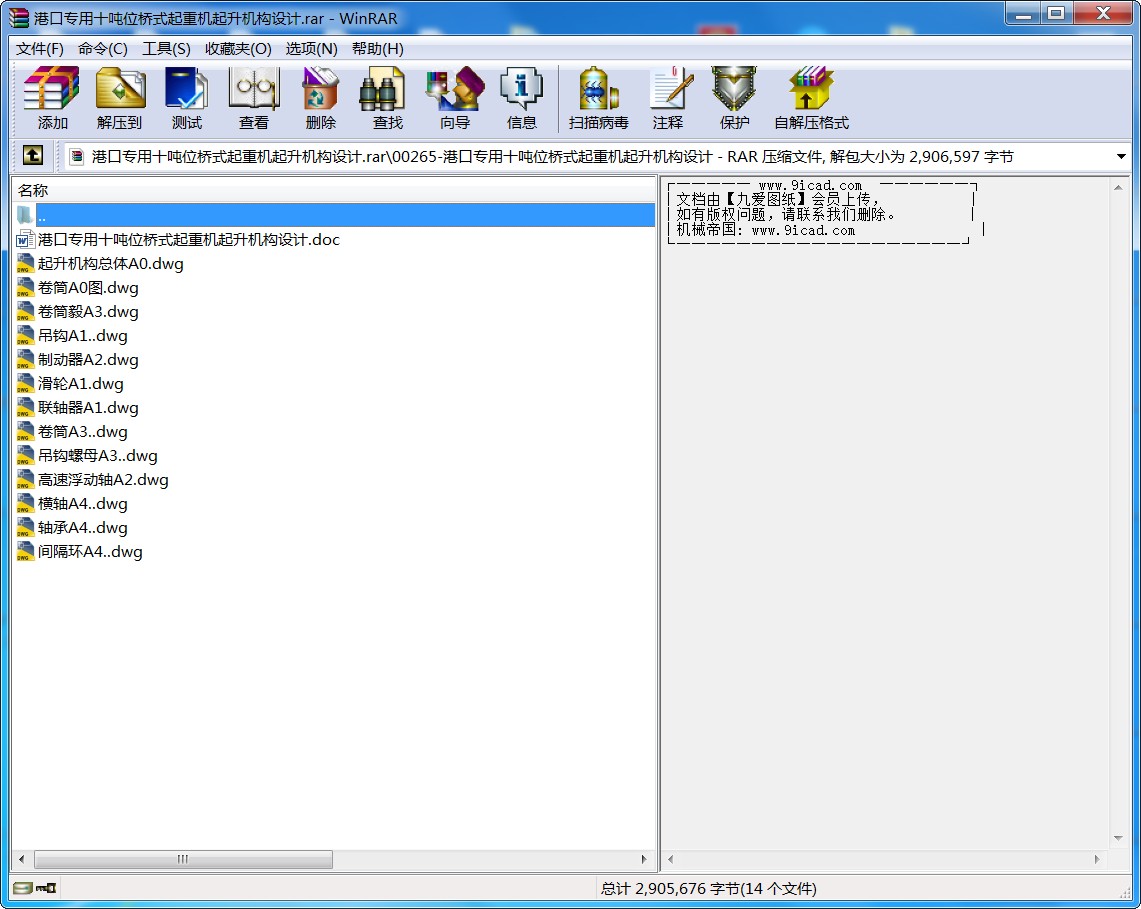港口專用十噸位橋式起重機(jī)起升機(jī)構(gòu)設(shè)計(jì)
- 文件介紹:
- 該文件為 rar 格式(源文件可編輯),下載需要
20 積分
-


- 港口專用十噸位橋式起重機(jī)起升機(jī)構(gòu)設(shè)計(jì).rar
摘 要
橋架在高架軌道上運(yùn)行的一種橋架型起重機(jī),又稱天車。橋式起重機(jī)的橋架沿鋪設(shè)在兩側(cè)高架上的軌道縱向運(yùn)行,起重小車沿鋪設(shè)在橋架上的軌道橫向運(yùn)行,構(gòu)成一矩形的工作范圍,就可以充分利用橋架下面的空間吊運(yùn)物料,不受地面設(shè)備的阻礙。這種起重機(jī)廣泛用在室內(nèi)外倉庫、廠房、碼頭和露天貯料場等處。由起升機(jī)構(gòu)、小車運(yùn)行機(jī)構(gòu)和小車架組成。起升機(jī)構(gòu)包括電動(dòng)機(jī)、制動(dòng)器、減速器、卷筒和滑輪組。電動(dòng)機(jī)通過減速器帶動(dòng)卷筒轉(zhuǎn)動(dòng),使鋼絲繩繞上卷筒或從卷筒放下,以升降重物。小車架是支托和安裝起升機(jī)構(gòu)和小車運(yùn)行機(jī)構(gòu)等部件的機(jī)架,通常為焊接結(jié)構(gòu)。
本文就十噸橋式起重機(jī)起升機(jī)構(gòu)做設(shè)計(jì)計(jì)算,計(jì)算起升機(jī)構(gòu)工作級別,確定起升機(jī)構(gòu)傳動(dòng)系統(tǒng),對起升機(jī)構(gòu)的部件滑輪、卷筒、鋼絲繩等卷繞系統(tǒng),電動(dòng)機(jī)、聯(lián)軸器、減速器等驅(qū)動(dòng)裝置進(jìn)行設(shè)計(jì)計(jì)算,驗(yàn)證卷筒壁壓應(yīng)力,卷筒應(yīng)力,確定吊鉤裝置構(gòu)造方案,吊鉤橫梁,滑輪軸的計(jì)算等。對起升機(jī)構(gòu)運(yùn)行的過程,包括起升速度、起升和制動(dòng)時(shí)間進(jìn)行計(jì)算和驗(yàn)算。
關(guān)鍵詞:驅(qū)動(dòng)裝置;起升運(yùn)行;傳動(dòng)方案;卷筒系統(tǒng)
ABSTRACT
Crane is used to start heavy materials, transportation, handling and installation of machinery and equipment and other operations, which can reduce manual labor, improve labor productivity and in the production process for some special process operation, mechanization and automation. Lifting mechanism includes a motor, brake, reducer, drum and pulley. Motor through reducer, driving drum rotation, so that the wire rope around the drum or from a roll down to lift heavy loads.
In this paper, ten tons crane hoisting mechanism to do the design calculations to determine the transmission scheme lifting mechanism, hoisting mechanism to determine the working level of the main components of the hoisting mechanism drum, wire rope, wire rope winding system pulleys, motors, United coupling, reducer drives the design calculations, validation reel wall stress, stress reel, hook device is configured to determine program, hook beams, pulley shaft calculation. Hoisting mechanism for running processes, including the lifting speed, lifting and braking time calculations and checking.
Keywords: transmission scheme; winding system; drive; lifting operation
目 錄
第 1 章 前 言 1
1.1 起重機(jī)械的發(fā)展 1
1.2橋式起重機(jī)的簡介 1
1.3起重機(jī)械的組成部分 2
1.4起重機(jī)械的特點(diǎn) 3
第2章 起升機(jī)構(gòu)部件的設(shè)計(jì)計(jì)算 4
2.1概 要 4
2.2主要數(shù)據(jù) 4
2.3確定起升機(jī)構(gòu)傳動(dòng)方案 4
2.4 確定吊鉤和滑輪組 6
2.5卷筒的計(jì)算 7
2.5.2 卷筒直徑計(jì)算 7
2.5.3 卷筒長度 7
2.5.4 卷筒壁壓應(yīng)力驗(yàn)算 8
2.5.5 卷筒應(yīng)力驗(yàn)算 8
2.6 繩端固定裝置的計(jì)算 10
2.7 取物裝置 11
2.7.1 確定吊鉤裝置構(gòu)造方案 11
2.7.2 吊鉤主體結(jié)構(gòu)的主要尺寸的計(jì)算 12
2.7.3 吊鉤強(qiáng)度驗(yàn)算 13
2.7.4 吊鉤彎曲部分?jǐn)嗝鍭-A強(qiáng)度驗(yàn)算 13
2.7.5 吊鉤彎曲部分?jǐn)嗝鍮-B強(qiáng)度驗(yàn)算 14
2.7.6 推力球軸承的選擇 15
2.7.7 吊鉤橫梁的計(jì)算 15
2.7.8 滑輪軸的計(jì)算 16
2.7.9 拉板的強(qiáng)度校核 18
第3章 起升運(yùn)行機(jī)構(gòu)設(shè)計(jì) 20
3.1 力矩的計(jì)算 20
3.1.1 平穩(wěn)上升階段 20
3.1.2 平穩(wěn)下降階段 21
3.1.3 上升起動(dòng)階段 22
3.1.4 下降制動(dòng)階段 23
3.2 電動(dòng)機(jī)的選擇 23
3.2.1 電動(dòng)機(jī)的功率確定 23
3.2.2 驗(yàn)算電動(dòng)機(jī)發(fā)熱條件 24
3.3 減速器的選擇 25
3.3.1 減速器傳動(dòng)比 25
3.3.2 減速器的選取 25
3.3.3 輸出軸強(qiáng)度校核 25
3.4 起升速度和實(shí)際所需功率 26
3.4.1 實(shí)際速度 26
3.4.2 實(shí)際功率 26
3.5 制動(dòng)器的選擇 26
3.6 起升和制動(dòng)時(shí)間驗(yàn)算 27
3.6.1 起動(dòng)時(shí)間驗(yàn)算 27
3.7 高速浮動(dòng)軸的計(jì)算 28
3.7.1 疲勞計(jì)算 28
3.7.2 強(qiáng)度驗(yàn)算 29
3.8 聯(lián)軸器的計(jì)算與選用 30
第4章 總結(jié)與展望 32
4.1 總結(jié) 32
4.2 展望 32
致 謝 33
參考文獻(xiàn) 34
...